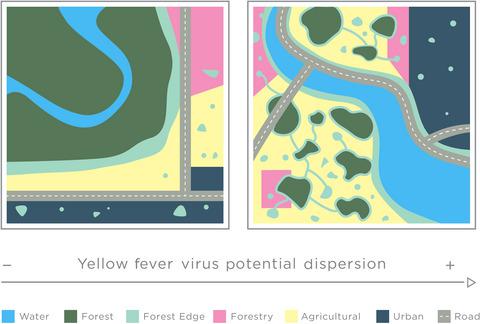当前位置:
X-MOL 学术
›
J. Appl. Ecol.
›
论文详情
Our official English website, www.x-mol.net, welcomes your
feedback! (Note: you will need to create a separate account there.)
Roads and forest edges facilitate yellow fever virus dispersion
Journal of Applied Ecology ( IF 5.0 ) Pub Date : 2021-09-18 , DOI: 10.1111/1365-2664.14031 Paula Ribeiro Prist 1 , Leandro Reverberi Tambosi 1, 2 , Luís Filipe Mucci 3 , Adriano Pinter 3 , Renato Pereira de Souza 4 , Renata L. Muylaert 5 , Jonathan R. Rhodes 6 , César Henrique Comin 7 , Luciano da F. Costa 8 , Tatiana Lang D’Agostini 9 , Juliana Telles de Deus 3 , Mônica Pavão 10 , Márcio Port‐Carvalho 11, 12 , Leila Del Castillo Saad 9 , Maria Anice Mureb Sallum 13 , Roberta Maria Fernandes Spinola 9 , Jean Paul Metzger 1
中文翻译:

道路和森林边缘促进黄热病病毒传播
更新日期:2021-10-06
Journal of Applied Ecology ( IF 5.0 ) Pub Date : 2021-09-18 , DOI: 10.1111/1365-2664.14031 Paula Ribeiro Prist 1 , Leandro Reverberi Tambosi 1, 2 , Luís Filipe Mucci 3 , Adriano Pinter 3 , Renato Pereira de Souza 4 , Renata L. Muylaert 5 , Jonathan R. Rhodes 6 , César Henrique Comin 7 , Luciano da F. Costa 8 , Tatiana Lang D’Agostini 9 , Juliana Telles de Deus 3 , Mônica Pavão 10 , Márcio Port‐Carvalho 11, 12 , Leila Del Castillo Saad 9 , Maria Anice Mureb Sallum 13 , Roberta Maria Fernandes Spinola 9 , Jean Paul Metzger 1
Affiliation

|
- Landscape connectivity is important for a wide range of ecological processes, including to disease spread, once it describes the degree to which landscapes facilitate or impede vector and hosts dispersion. Understanding connectivity is extremely important to identify where pathogens can move, and at what speed, allowing the organization of vaccination campaigns or other preventive measures.
- To better understand the effects of landscape connectivity on yellow fever virus (YFV) dispersion in Brazil, we used a network approach and modelled the movement of non-human primates' cases, the so-called epizootic events, over time. The networks consider each epizootic event as a node and the dispersion between nodes as links. Those links were established considering, respectively, the date of each epizootic event, the distance among the nodes and the permeability of the landscape between each pair of nodes.
- Our results demonstrated that on average YFV dispersed 1.42 km/day, with the largest movement being 6.9 km/day. Dispersions were longer in summer (1.2 km/day) than in winter (0.22 km/day). Most dispersal movements occurred up to 1 km/day (71%) and within a week after the arrival of the virus in the source node (73%), except in winter, where dispersions occurred within a period of up to 20 days. The best model indicates that YFV disperses mainly through roads adjacent to forest areas, and along forest edges (within a range of 100 m) in interface with agricultural areas, water and forestry areas. Core areas of urban, agricultural and forest regions were important barriers for virus movement.
- Synthesis and applications. Through landscape connectivity analyses, we provided here the first evidence that highly fragmented landscapes with a wide road network and large densities of forest edges facilitate yellow fever virus propagation, and that the maintenance of large blocks of forest can help to inhibit this spread. These results can contribute to guide forest restoration and landscape management actions in order to amplify health benefits related to restoration projects, in addition to their benefits for biodiversity conservation and climate change mitigation.
中文翻译:

道路和森林边缘促进黄热病病毒传播
- 景观连通性对于广泛的生态过程很重要,包括疾病传播,一旦它描述了景观促进或阻碍媒介和宿主分散的程度。了解连通性对于确定病原体可以移动的位置和速度非常重要,从而允许组织疫苗接种活动或其他预防措施。
- 为了更好地了解景观连通性对巴西黄热病病毒 (YFV) 传播的影响,我们使用了网络方法并对非人类灵长类动物病例(即所谓的流行病事件)随时间的移动进行了建模。网络将每个流行病事件视为一个节点,将节点之间的分散视为链接。这些联系的建立分别考虑了每个流行事件的日期、节点之间的距离以及每对节点之间的景观渗透性。
- 我们的结果表明,YFV 平均每天分散 1.42 公里,最大运动为 6.9 公里/天。夏季(1.2 公里/天)的扩散时间长于冬季(0.22 公里/天)。大多数传播运动发生在每天 1 公里 (71%) 以内,并且发生在病毒到达源节点后的一周内 (73%),但冬季除外,冬季传播的时间长达 20 天。最佳模型表明,YFV 主要通过与林区相邻的道路以及沿林缘(100 m 范围内)与农区、水区和林区交界处扩散。城市、农业和林区的核心区域是病毒传播的重要障碍。
- 合成与应用。通过景观连通性分析,我们在此提供了第一个证据,即具有广泛道路网络和高密度林缘的高度分散的景观促进了黄热病病毒的传播,并且大片森林的维护有助于抑制这种传播。这些结果有助于指导森林恢复和景观管理行动,以扩大与恢复项目相关的健康益处,以及它们对生物多样性保护和减缓气候变化的益处。











































 京公网安备 11010802027423号
京公网安备 11010802027423号